Why do some ideas spread like wildfire while others sprout and die out?
Why do some great ideas, with world-altering potential, die on the vine–never to grace us with their fruit? When, if communicated properly, they might have turned our world upside down?
We’ll explore those questions with Dan Heath, co-author of the bestselling book, “Made to Stick.”
But first …
I pitched an idea for a new product and promotional campaign to our company Leadership Board. It’s titled …
The Terrible Tumultuous Terrestrial Total Tipover
The scene: The world is struck by an electromagnetic storm of apocalyptic proportion. It’s causing the earth to tip over on its axis. All life will be wiped out in a flash. Unimaginable horrors.
But wait!
At the last second, our product saves the day, saves the world, and sets the earth upright. All is good, all is great, and all was accomplished in less than 30 seconds. In the pitch, I promised to include a minimum of 15,789 undecipherable corporate acronyms in the promotional copy.
Pretty much routine marketing stuff.
I know. It might need a little more drama and dynamics. But the basics are there. I mean look at how many times Will Smith has pulled that idea off. He’s saved the world at least five times. Hasn’t he?
Now you have to understand interpersonal dynamics to properly interpret the board’s response. First, there was silence. Some would say deafening silence. But then, it started … slowly at first, building into a muffled crescendo.
Hailed as a creative hero
They hailed my creativity with accolades such as “malodorous,” “fetid,’ “unimaginative,” “non-stimulating,”and “provocative vomitus eruptus”(the boss speaks Latin). If you understand inter-relational personal dynamics in a business setting, you’ll know those are code words for “great” “astounding,” visionary,” – and the coup de grace, “Obama-like.” It’s hard not to get a big head when praise like that is lavished upon you, but I’ve learned to handle it.
They did ask me to refine the idea a little, and our CMO had a book he wanted me to read to help with the refinement process. He said he’d send it down later.
So, I went to work. But being creative is hard work.
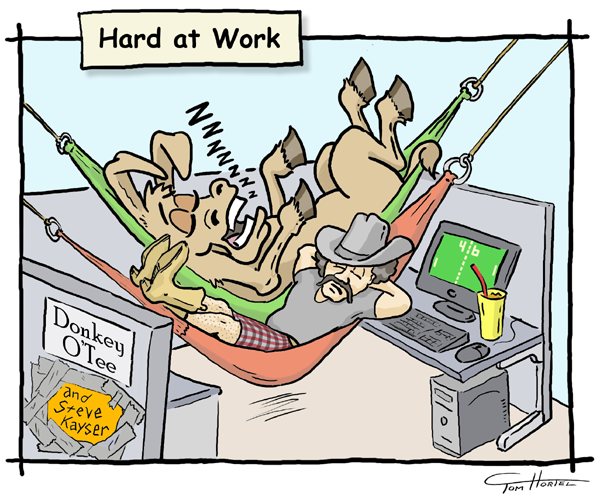 I was in my groove – some would say I was “dreamstorming” – when my sixth sense tingled. You know, that feeling you get when you’re on the edge of sleep and something startles you? Like a very loud sound.
I was in my groove – some would say I was “dreamstorming” – when my sixth sense tingled. You know, that feeling you get when you’re on the edge of sleep and something startles you? Like a very loud sound.
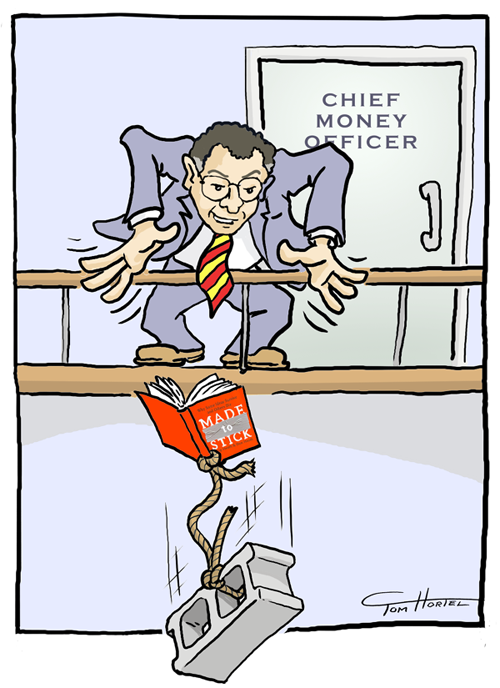 That’s when I realized the book the CMO wanted me to review …
That’s when I realized the book the CMO wanted me to review …
… had arrived. And, as most corporate communications go, it had a note attached – one that was quite obtuse, not very direct, and in fact, very subtle.
“READ THIS. Then follow the advice or – YOU’RE FIRED!”
I had to contemplate its true meaning for a while. Then, understanding the nuances, I took it like a real man – a real kilt-wearing man.
Takes decisive action
Then I took action. I read. I mulled. I quickly realized the author was in complete denial of the true steps of creating great ideas. I needed to straighten him out.
So I did.
ENTER: Dan Heath, Co-Author of Made to Stick: Why Some Ideas Survive and Others Die, which has been a New York Times, Wall Street Journal, and BusinessWeek bestseller. Dan is also a columnist for Fast Company magazine. Steve: Thanks for taking the time out for this interview. You say in your book there are six key qualities that make an idea stick. What are they?
Dan: Well, what do you think they are?
Steve: Hey! I’m the one that’s supposed to be asking the questions here. The boss wants me to read and dispute your stuff before he’ll consider me for bigger opportunities. Like complete ownership of the company … if you must know.
Dan: What are your six keys? You already know mine … if you’ve read the book.
Steve: Okay then. I’ll go first. All great ideas have to be:
- Complex – intricate, Byzantine in their machinations
- Obvious – so people don’t have to think too hard
- Nebulous – so you don’t commit to any particular result
- Incredible – so people will be in awe of your creativity
- Emotionless– neutral, detached, faux objective and above all …
- Communicated with 382 bullet-pointed facts on 97 PowerPoint slides
Dan: Interesting. We found in our book that the six key qualities of ideas that are Made to Stick are:
- Simplicity – stripping an idea to its core
- Unexpectedness – able to capture and hold people’s attention
- Concreteness – easily understood and remembered
- Credibility – is believable
- Emotional – gets people to care about the idea
- Stories – told in a storytelling manner
Steve: I see great minds think alike. We might use different words and terms, but we arrive at the same conclusion. However, I would just like to point out that your six key qualities form a mnemonic. People will remember it. That means they’ll crib it from you. Don’t you want to keep that intellectual capital proprietary? You should learn from me. I keep all of my intelligence hidden.
Dan: Yes, I can see that. Arch Villain Steve: What’s the number-one barrier, the arch villain, of “sticky” ideas? What keeps great ideas (like mine) from taking off?
Dan: “The Curse of Knowledge” is the arch villain in our book. Here’s what it means: The more we know about something, the harder it is for us to imagine not knowing it. As a result, we become lousy communicators.
Think of the IT guy in the office who can’t give you a clear answer to some computer question. All the vast experience he has with computers renders him unable to fathom how little you know. He talks in jargon and abstractions that you can’t follow. We are all like the IT guy in our own domain of expertise. If we know enough to come up with an important insight, we also know too much to communicate easily with others.
That’s why knowledge can be a curse, as well as a blessing.
Steve: What is the real-life disconnect between the Answer stage and the Telling stage of great ideas?
Dan: Getting a message across has two stages: the Answer stage and the Telling Others stage.
In the Answer stage, you use your expertise to arrive at the idea you want to share. Doctors may study for a decade to get the Answer. Business managers may deliberate for months to arrive at the Answer.
Here’s the rub: The same factors that worked so well for you in the Answer stage, will backfire on you during the Telling Others stage. To get the Answer, you need expertise; you need research and deep abstract thinking. But, all of that expertise almost guarantees the Curse of Knowledge. You will come to know things that others don’t, and you’ll forget what it was like not to know those things. So when you get around to sharing the Answer, you’ll tend to communicate as if your audience was you.
The tragedy, in my judgment, is the sheer imbalance between the amount of time we spend arriving at the Answer and the amount of time we invest in Telling Others. What would you guess is the ratio? My guess is probably 50:1. That’s a mistake, because we all know that having a good idea – having the Right Answer – isn’t enough. Lots of great ideas never go anywhere. For your idea to make a difference, it’s got to stick. And that’s where our book comes in.
Steve: What is your favorite story in Made to Stick?
Dan: Probably JFK’s speech from 1961. He challenged the nation to put a man on the moon and return him safely within the decade. That was a sticky idea that motivated a nation of millions for the better part of a decade. The “man on the moon” idea captures perfectly the six principles of sticky ideas: it’s simple, unexpected, concrete, credible, emotional, and it’s a story (in miniature).
Think about the concreteness in particular. Was there a single person on the planet who didn’t understand exactly what success would look like? That’s remarkable! Are your company’s goals that clear?
Steve: I understand concrete concreteness now. I really do.
Dan: If JFK had been a modern-day politician or CEO, he’d probably have said, “Our mission is to become the international leader in the space industry, using our capacity for technological innovation to build a bridge toward humanity’s future.” We might not have ever made it to the moon.
Steve: Why has “Made to Stick” stuck?
Dan: The honest answer is, I have no clue as to why the book has stuck so well. It certainly wasn’t our prediction that we’d spend 21 months on the BusinessWeek bestseller list. We did work really hard to use our own principles when we wrote the book – we told lots of stories, we tried to make concepts concrete, etc. And, Random House did a great job introducing the book to the public. But let’s be honest, there are some really well-written books out there, with fascinating ideas in them, with great marketing campaigns behind them, that don’t sell very well. So, while I’d love to claim that the book worked because of the visionary genius of my brother, Chip, and I, it’s more accurate to say that we just got lucky.
However, it’s flattering to think we’ve passed the CMO test!
Steve: Yes. I was introduced to the “concreteness” concept of sticky ideas because the CMO liked your book.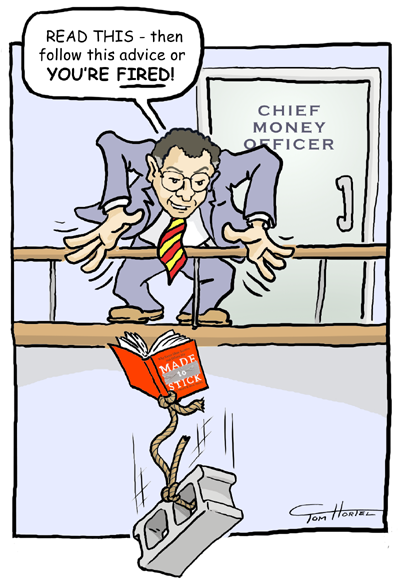
Steve: Thanks Dan for taking the time to do this interview. Of all this, I will forever remember one key point …
So, after the interview and much contemplation, I refined my idea of the …
Terrible Tumultuous Terrestrial Total Tipover
Slightly. I added a part where we have to “put a man on the moon” using our product to save the world.
Brilliant isn’t it? I presented the idea to the company Leadership Board.
It stuck.
At least I did.
END:

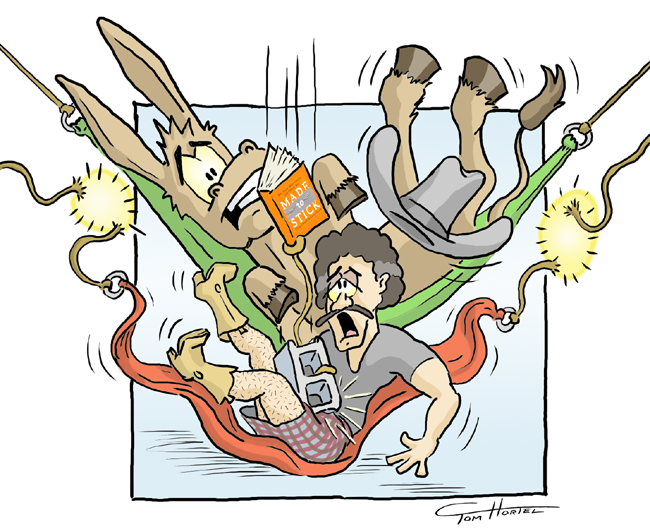
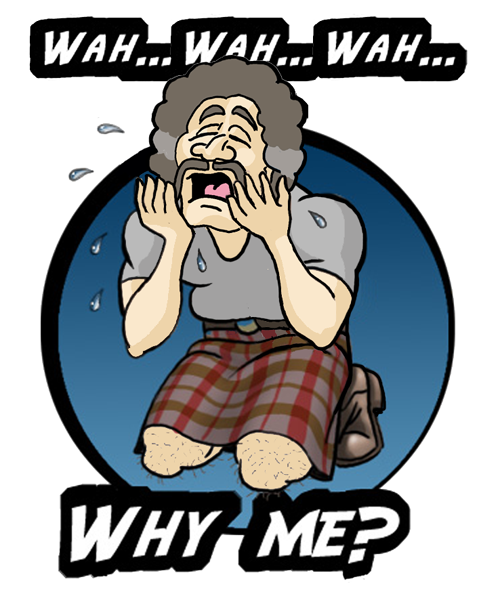
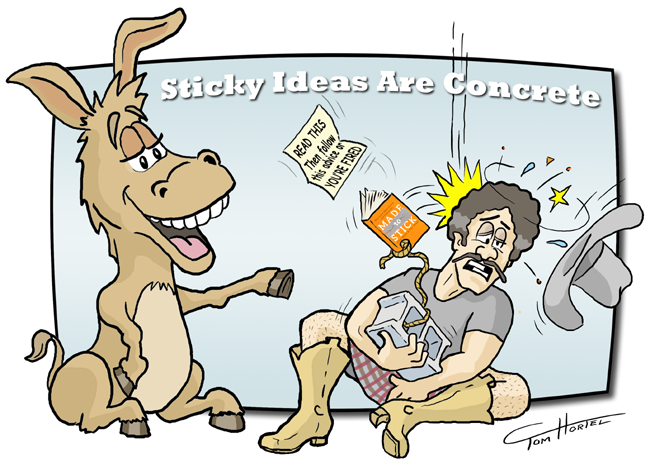
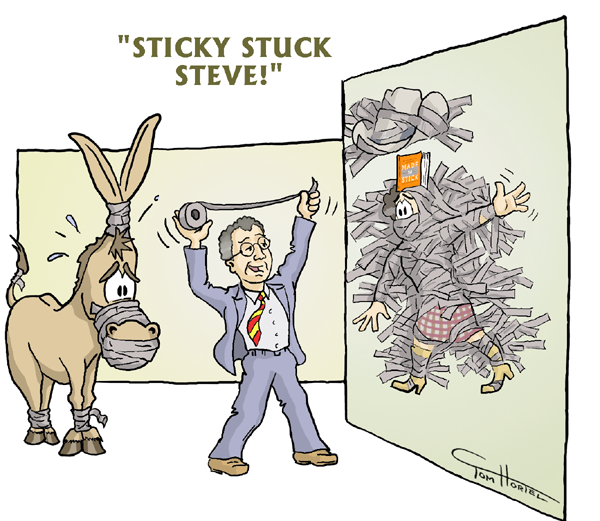

Recent Comments
Lessons Learned from Hollywood STORY Guru Robert McKee